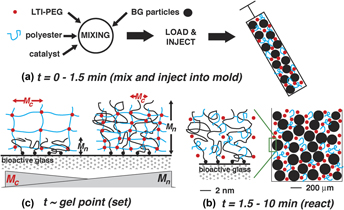Crossref Citations
This article has been cited by the following publications. This list is generated based on data provided by
Crossref.
Harmata, Andrew J.
Uppuganti, Sasidhar
Granke, Mathilde
Guelcher, Scott A.
and
Nyman, Jeffry S.
2015.
Compressive fatigue and fracture toughness behavior of injectable, settable bone cements.
Journal of the Mechanical Behavior of Biomedical Materials,
Vol. 51,
Issue. ,
p.
345.
Feng, Pei
Guo, Xiaoning
Gao, Chengde
Gao, Dan
Xiao, Tao
Shuai, Xiong
Shuai, Cijun
and
Peng, Shuping
2015.
Diopside modified porous polyglycolide scaffolds with improved properties.
RSC Advances,
Vol. 5,
Issue. 68,
p.
54822.
Fernando, S.
McEnery, M.
and
Guelcher, S.A.
2016.
Advances in Polyurethane Biomaterials.
p.
481.
McEnery, Madison A. P.
Lu, Sichang
Gupta, Mukesh K.
Zienkiewicz, Katarzyna J.
Wenke, Joseph C.
Kalpakci, Kerem N.
Shimko, Daniel A.
Duvall, Craig L.
and
Guelcher, Scott A.
2016.
Oxidatively degradable poly(thioketal urethane)/ceramic composite bone cements with bone-like strength.
RSC Advances,
Vol. 6,
Issue. 111,
p.
109414.
Talley, Anne D.
Kalpakci, Kerem N.
Shimko, Daniel A.
Zienkiewicz, Katarzyna J.
Cochran, David L.
and
Guelcher, Scott A.
2016.
Effects of Recombinant Human Bone Morphogenetic Protein-2 Dose and Ceramic Composition on New Bone Formation and Space Maintenance in a Canine Mandibular Ridge Saddle Defect Model.
Tissue Engineering Part A,
Vol. 22,
Issue. 5-6,
p.
469.
Harmata, A.J.
and
Guelcher, S.A.
2016.
Nanocomposites for Musculoskeletal Tissue Regeneration.
p.
67.
Zhang, Chunchen
Chang, Ming-Wei
Li, Yudong
Qi, Yuankai
Wu, Jingwen
Ahmad, Zeeshan
and
Li, Jing-Song
2016.
Janus particle synthesis via aligned non-concentric angular nozzles and electrohydrodynamic co-flow for tunable drug release.
RSC Advances,
Vol. 6,
Issue. 81,
p.
77174.
Shiels, Stefanie M.
Talley, Anne D.
McGough, Madison A. P.
Zienkiewicz, Katarzyna J.
Kalpakci, Kerem
Shimko, Daniel
Guelcher, Scott A.
and
Wenke, Joseph C.
2017.
Injectable and compression-resistant low-viscosity polymer/ceramic composite carriers for rhBMP-2 in a rabbit model of posterolateral fusion: a pilot study.
Journal of Orthopaedic Surgery and Research,
Vol. 12,
Issue. 1,
Lu, S.
McGough, M. A. P.
Rogers, B. R.
Wenke, J. C.
Shimko, D.
and
Guelcher, S. A.
2017.
Resorbable nanocomposites with bone-like strength and enhanced cellular activity.
Journal of Materials Chemistry B,
Vol. 5,
Issue. 22,
p.
4198.
Mukhopadhyay, S.
2018.
Fundamental Biomaterials: Ceramics.
p.
129.
Lu, Sichang
McGough, Madison A.P.
Shiels, Stefanie M.
Zienkiewicz, Katarzyna J.
Merkel, Alyssa R.
Vanderburgh, Joseph P.
Nyman, Jeffry S.
Sterling, Julie A.
Tennent, David J.
Wenke, Joseph C.
and
Guelcher, Scott A.
2018.
Settable polymer/ceramic composite bone grafts stabilize weight-bearing tibial plateau slot defects and integrate with host bone in an ovine model.
Biomaterials,
Vol. 179,
Issue. ,
p.
29.
Robo, Céline
Öhman-Mägi, Caroline
and
Persson, Cecilia
2018.
Compressive fatigue properties of commercially available standard and low-modulus acrylic bone cements intended for vertebroplasty.
Journal of the Mechanical Behavior of Biomedical Materials,
Vol. 82,
Issue. ,
p.
70.
McGough, Madison A. P.
Boller, Lauren A.
Groff, Dustin M.
Schoenecker, Jonathan G.
Nyman, Jeffry S.
Wenke, Joseph C.
Rhodes, Cheyenne
Shimko, Dan
Duvall, Craig L.
and
Guelcher, Scott A.
2020.
Nanocrystalline Hydroxyapatite–Poly(thioketal urethane) Nanocomposites Stimulate a Combined Intramembranous and Endochondral Ossification Response in Rabbits.
ACS Biomaterials Science & Engineering,
Vol. 6,
Issue. 1,
p.
564.
Font Tellado, Sonia
Delgado, José Angel
Poh, Su Ping Patrina
Zhang, Wen
García-Vallés, Maite
Martínez, Salvador
Gorustovich, Alejandro
Morejón, Lizette
van Griensven, Martijn
and
Balmayor, Elizabeth Rosado
2021.
Phosphorous pentoxide-free bioactive glass exhibits dose-dependent angiogenic and osteogenic capacities which are retained in glass polymeric composite scaffolds.
Biomaterials Science,
Vol. 9,
Issue. 23,
p.
7876.
Ezquerro, Carlos Sáenz
Aznar, José Manuel García
and
Laspalas, Manuel
2022.
Prediction of the structure and mechanical properties of polycaprolactone–silica nanocomposites and the interphase region by molecular dynamics simulations: the effect of PEGylation.
Soft Matter,
Vol. 18,
Issue. 14,
p.
2800.
Mukundan, Lakshmi M.
Bora, Hema
Rajasekaran, Ragavi
Dhara, Santanu
and
Chattopadhyay, Santanu
2023.
Shell-sheddable antibiotic nanohybrid through drug-mediated surface-initiated polymerization: an overcoat approach for modulated burst release.
Journal of Materials Science,
Vol. 58,
Issue. 7,
p.
3094.
Li, Guanjin
Li, Yushu
Yang, Likai
Hong, Lingyi
Dong, Xinyu
Tan, Vincent Beng Chye
and
Zhai, Wei
2025.
Strong hybrid cellular/lamellar ceramic/polymer composites via emulsification freeze casting.
Journal of the American Ceramic Society,
Vol. 108,
Issue. 2,



